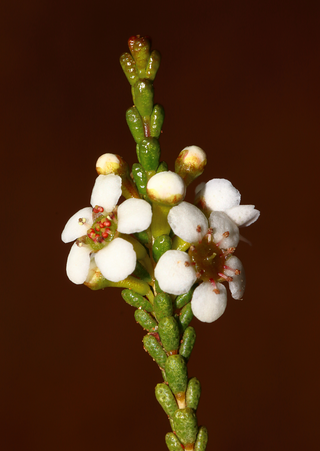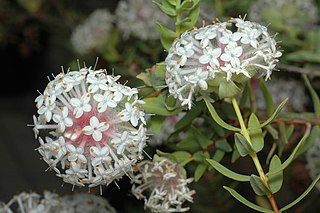Persoonia micranthera, commonly known as the small-flowered snottygobble, is a species of flowering plant in the family Proteaceae and is endemic to a restricted area in the south-west of Western Australia. It is a low-lying to prostrate shrub with branchlets that are hairy when young, spatula-shaped to lance-shaped leaves with the narrower end towards the base, hairy yellow flowers borne in groups of four to fifteen, and smooth, oval fruit.
Grevillea rogersoniana, commonly known as Rogerson's grevillea, is a species of flowering plant in the family Proteaceae and is endemic to a restricted area near Shark Bay in Western Australia. It is an erect shrub with spatula-shaped leaves with 3 to 5 teeth or shallow lobes on the end, and cylindrical clusters of reddish pink flowers, the style with a cream-coloured tip.

Calytrix formosa is a species of flowering plant in the myrtle family Myrtaceae and is endemic to the west of Western Australia. It is a glabrous shrub with erect, elliptic, broadly elliptic or oblong leaves, and pink flowers with about 90 to 105 stamens in multiple rows.

Micromyrtus clavata is a species of flowering plant in the family Myrtaceae and is endemic to inland Western Australia. It is an erect, compact or sprawling shrub with erect, egg-shaped leaves with the narrower end towards the base and small white flowers arranged singly in upper leaf axils.
Micromyrtus mucronulata species of the family Myrtaceae and is endemic to the Western Australia. It is a shrub with linear to narrowly egg-shaped leaves with the narrower end toward the base, and white flowers 3.0–3.5 mm (0.12–0.14 in) in diameter.
Micromyrtus prochytes is species of the flowering plant in the family Myrtaceae and is endemic to inland areas of Western Australia. It is an erect shrub with narrowly egg-shaped leaves with the narrower end toward the base, and white or pink flowers 3.0–4.0 mm (0.12–0.16 in) in diameter.
Olearia occidentissima is a species of flowering plant in the family Asteraceae and is endemic to the extreme west of Western Australia. It is an erect or prostrate, wind-pruned shrub with narrowly elliptic leaves that are woolly-hairy on the lower surface, and white, daisy-like inflorescences.

Pimelea avonensis is a species of flowering plant in the family Thymelaeaceae and is endemic to the south-west of Western Australia. It is a shrub with narrowly egg-shaped or elliptic leaves and clusters of white, tube-shaped flowers.
Cryptandra apetala is a species of flowering plant in the family Rhamnaceae and is endemic to the south-west of Western Australia. It is a shrub with tufted, linear to lance-shaped leaves, and urn-shaped white to creamy-white and pink flowers arranged on short side shoots.
Cryptandra micrantha is a flowering plant in the family Rhamnaceae and is endemic to the southwest of Western Australia. It is a prostrate or upright shrub with spiny branchlets, narrowly oblong to elliptic leaves and dense clusters of white or cream-coloured, tube-shaped flowers.

Stenanthemum nanum is a species of flowering plant in the family Rhamnaceae and is endemic to the south-west of Western Australia. It is a prostrate shrub with hairy young stems, broadly egg-shaped leaves with the narrower end towards the base, and densely silvery-hairy heads of white or cream-coloured flowers.
Conostephium laeve is a species of flowering plant in the family Ericaceae and is endemic to the west of Western Australia. It is a compact shrub with erect, narrowly elliptic or narrowly egg-shaped leaves with the narrower end toward the base, and pendulous, spindle-shaped, cream to straw-coloured and pink flowers.
Xanthosia eichleri is a species of flowering plant in the family Apiaceae and is endemic to the south of Western Australia. It is an erect, low-lying or prostrate subshrub with wedge-shaped leaves and mostly bisexual, cream-coloured or white flowers.
Ptilotus actinocladus is a species of flowering plant in the family Amaranthaceae and is endemic to inland Western Australia. It is a prostrate annual herb with a central stem and radiating lateral stems, linear to lance-shaped stem leaves, pink spherical or cylindrical spikes of flowers with long, silky hairs, and four fertile stamens.

Ptilotus aervoides, commonly known as mat mulla mulla, is a species of flowering plant in the family Amaranthaceae and is endemic to western Australia. It is a prostrate, mat-forming annual or short-lived perennial herb, its stems densely hairy at first, egg-shaped to spatula-shaped stem leaves, dense spikes of hairy creamy-green flowers with two or three fertile stamens.
Balaustion filifolium is a species of flowering plant in the family Myrtaceae and is endemic to inland Western Australia. It is a prostrate or low-growing shrub with narrowly egg-shaped to linear leaves with a small point on the end, and pale pink flowers with 16 to 24 stamens.

Ptilotus albidus is a species of flowering plant in the family Amaranthaceae and is endemic to inland Western Australia. It is a compact perennial shrub with linear leaves, spherical spikes of white flowers and dull brown seeds.
Ptilotus alexandri is a species of flowering plant in the family Amaranthaceae and is endemic to the far west of Western Australia. It is an erect, annual herb with spatula-shaped leaves, spikes of pink flowers and glossy black seeds.

Ptilotus aphyllus is a species of flowering plant in the family Amaranthaceae and is endemic to the a small area of inland Western Australia. It is a leafless perennial, except when young, and spikes of purple flowers fading to pink and pale orange.

Ptilotus appendiculatus is a species of flowering plant in the family Amaranthaceae and is endemic to the north of Western Australia. It is a prostrate perennial herb with egg-shaped leaves and spikes of pink flowers.








